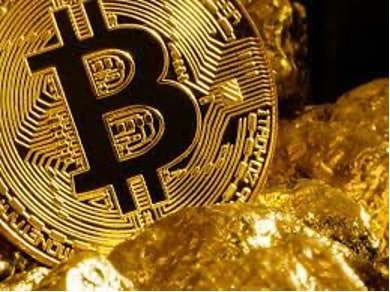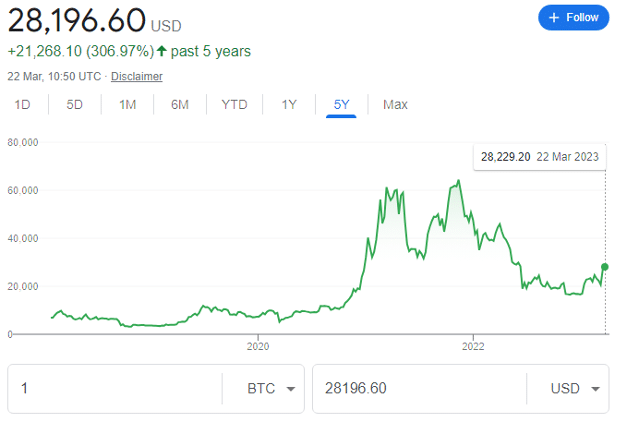Explaining the value interplay between Gold, Bitcoin, the US Dollar, and defensive stocks in simple layman’s terms.

When monetary policy is loose, interest rates are low, and growth is cheap. In this boom phase of the economic cycle investors often pile their capital into tech stocks, which thrive on the waters of cheap debt. However, those who have been around the block a couple of times know that for every boom, there’s a bust.
In the most recent case, excessive currency printing to prop up the global economy during the pandemic, pent-up demand as the lockdowns ended, and further disruptions of supply chains caused by the Ukraine War have all conspired to create a serious crash in equities, crypto and various other asset classes.
However, many investors retained a defensive fortification of diversification by owning some Gold, some Bitcoin, some US Dollars, and some defensive stocks to hedge both for inflation and for a time when interest rates would start to rise.
And this strategy is unlikely to change anytime soon.
Gold
Gold — and to some extent silver as well — is the go-to traditional real asset inflationary hedge in times of severe economic stress.

Over the past ten years, gold has risen by more than 50% to a near-record £1,582/oz, driven by central bank quantitative easing increasing the relative value of the precious metal.
Indeed, gold tends to have an inverse relationship to the strength of the US Dollar — if the Federal Reserve increases the federal funds rate, then this generates a better rate of return for dollar investors, especially if it simultaneously engages in quantitative tightening to reduce the amount of dollars in existence.
Given the chaos in the international banking sector, including the collapse of Silicon Valley Bank and near-collapse of Credit Suisse, there is now uncertainty that the US Federal Reserve will continue to hike rates as high or as aggressively as they have been in the recent past.
This reduces the relative value of the dollar, as investors get a smaller return on dollars held — and increases the relative value of gold.
Of course, unlike equities or currency, the precious metal pays no interest or dividends. As Warren Buffett — who will likely play a key part in the banking rescue — notes, ‘it doesn’t do anything but sit there and look at you.’
However, in recessionary periods gold is a valuable asset to own. In 2008, the US economic benchmark S&P 500 fell by 37%, while gold rose by 24%. The largest US stocks are in the tech sector, which again rely on low interest rates — so to a weaker extent, the gold price rises when the S&P 500 falls, and this is partially why gold is known as a key inflationary hedge.

For perspective, the S&P 500 fell from 4,766 points to 3,840 points in 2022, while gold rose from at £1358.06/oz to £1514.53/oz by the end of the year. The problem is that when the recovery comes — and this can be extremely rapid — gold then reduces in value compared to growth stocks.
Some investors prefer to apportion a part of their portfolio to defensive stocks in sectors such as utilities, food producers, tobacco, or pharmaceuticals. These companies experience constant demand regardless of the prevailing economic climate as investors benefit from inelasticity.
Consumers need food, heating, and medicine, and will pay inflation-matching prices. These types of defensive stocks — often found on the FTSE 100 — usually are low growth, so investors can benefit both from steady capital growth and reliable dividends. Indeed, the FTSE 100 rose by 1% in 2022, but also returned £79.1 billion in dividend returns in the year. And this return excludes share buybacks, which also rose.
For those seeking the safe haven of the global reserve currency — the US Dollar — returns were also fairly strong in 2022, with the currency appreciating by 12% in the year, and hitting a two-decade high in September.
It’s worth noting there are threats to the US Dollar remaining as the hedging currency of choice: the US printed trillions during the pandemic, increasing the Federal Reserve’s balance sheet to $9 trillion. Reducing this balance — aka quantitative tightening — is going to cause significant economic damage, akin to the rising rates.
But keeping the balance elevated means that the true value of the Dollar has fallen. Arguably, as every other country also printed excessively, then the only thing that matters is the relative strength of the Dollar to other fiat currencies. If this is the case, then it could maintain its pole position with little trouble.
However, there are two spanners in the works. One is the rise of China, which has made no secret of its ambitions to have the Yuan replace the US Dollar as the reserve currency of choice. I have reservations about this happening due to the communist nature of the CCP, though the potential BRICS reserve currency could be more effective.
However, there is an alternative currency — a little cryptocurrency project known as Bitcoin — that may take the Dollar’s spot in time. Of course, those hoping that Bitcoin would act as an inflationary hedge in 2022 were sorely disappointed, with the most famous crypto losing 65% of its value in the year.

However, it’s now up 70% year-to-date to circa $28,000. And given the performance of some of the most popular US equities, the argument that the crypto is more volatile than traditional assets appears to have dissolved.
And as only 21 million can ever be mined, it’s possible that the mass adoption that converts have been hoping for is now around the corner. As fiat currencies devalue to stop the spread of financial contagion, the decentralised and enforced deflationary nature of the crypto is starting to look more attractive as a long-term investment. Ironically, a US Reserve pivot could also see more cash poured into Bitcoin investing.
Further, global regulatory reform could lead to increased investor confidence, as well as the collapse of hundreds of altcoin projects which could see current crypto investors pour into one of the last remaining proof-of-work currencies.
But there are huge risks — including the yet-to-be-touched stockpile of inventor ‘Satoshi Nakamoto,’ and the chance of negative regulatory reform. And there are hundreds of analysts who consider the alternative asset essentially worthless. But importantly, over the past five years, Bitcoin has outperformed the other three traditional hedges by a wide margin.
This leaves keeping all four inflationary hedges in the portfolio as a common way to prepare for economic stress.
This article has been prepared for information purposes only by Charles Archer. It does not constitute advice, and no party accepts any liability for either accuracy or for investing decisions made using the information provided.
Further, it is not intended for distribution to, or use by, any person in any country or jurisdiction where such distribution or use would be contrary to local law or regulation.